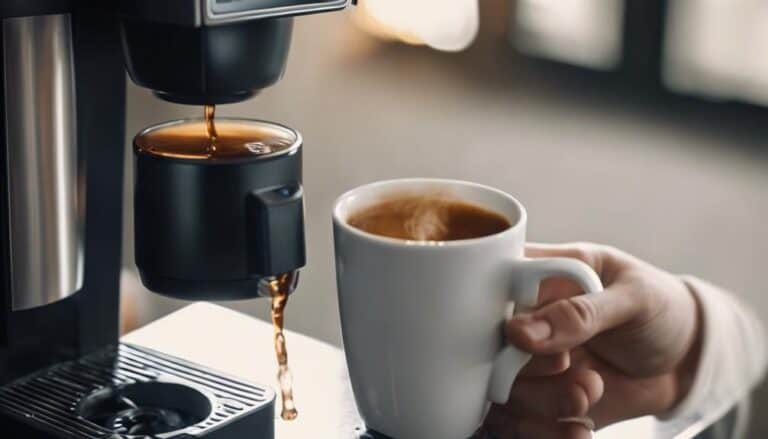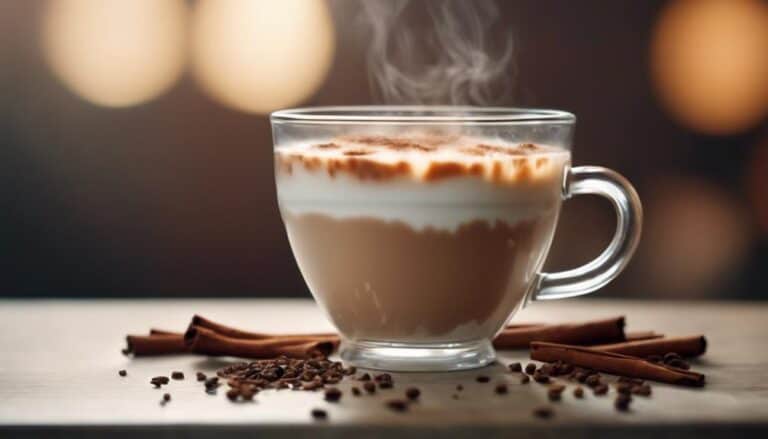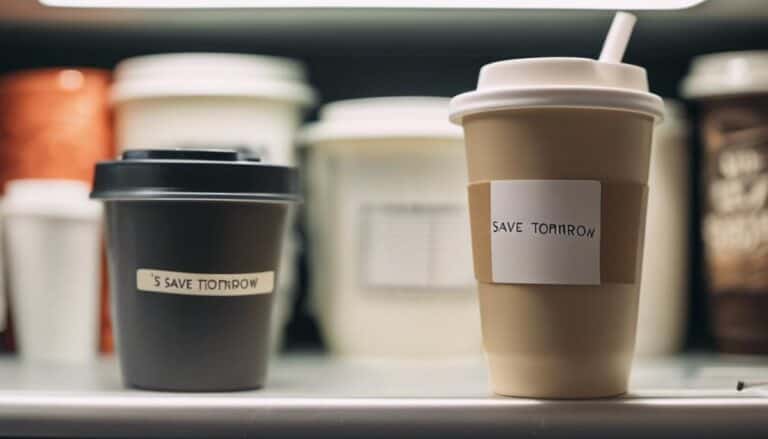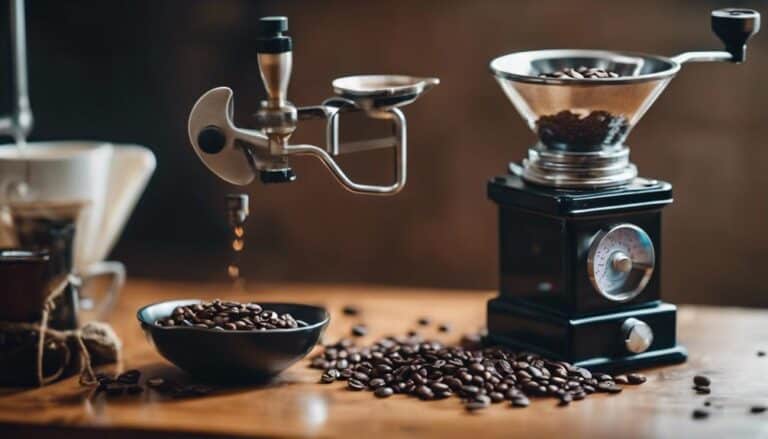How Many Cups of Coffee Grounds per Cup: A Guide to Perfect Coffee Brewing

When it comes to brewing coffee, one of the most important factors to consider is the coffee-to-water ratio. This ratio determines the strength and flavor of the coffee, and it can be adjusted based on personal preference. One common question that arises is how much coffee grounds to use per cup of water.

The answer to this question depends on a few factors, including the type of coffee being used, the brewing method, and personal taste preferences. Generally, a good starting point is to use one to two tablespoons of coffee grounds per six ounces of water. However, some people prefer a stronger or weaker cup of coffee, so the ratio can be adjusted accordingly.
It’s worth noting that different brewing methods require different ratios of coffee to water. For example, a French press typically requires a higher ratio of coffee to water than a drip coffee maker. Additionally, the type of coffee being used can affect the strength and flavor of the final product. With these factors in mind, it’s important to experiment with different ratios and methods to find the perfect cup of coffee.
Understanding Coffee Basics
When it comes to brewing coffee, the amount of coffee grounds you use is just as important as the quality of the beans and the brewing method. The right amount of coffee grounds per cup can make all the difference in the taste and strength of your coffee.
Coffee Beans and Roast
Coffee beans are the seed of the coffee plant, and they come in different varieties that have different flavors and aromas. The roast of the coffee beans also affects the flavor and strength of the coffee. Darker roasts tend to have a stronger, more bitter taste, while lighter roasts have a milder, more acidic taste.
Freshly Roasted Beans
Freshly roasted beans are essential for a great cup of coffee. Coffee beans start losing flavor and aroma as soon as they are roasted, so it’s best to use them within two weeks of roasting. If you have access to freshly roasted beans, use them to get the best flavor and aroma in your coffee.
Caffeine
Caffeine is a natural stimulant found in coffee that can help you stay alert and focused. The amount of caffeine in coffee can vary depending on the type of coffee and the brewing method. Specialty coffee, which is made from high-quality beans and brewed using precise methods, tends to have more caffeine than regular coffee.
Specialty Coffee Association of America (SCAA)
The Specialty Coffee Association of America (SCAA) is an organization that sets standards for specialty coffee. They provide guidelines for brewing coffee, including the amount of coffee grounds per cup. According to the SCAA, the ideal ratio of coffee grounds to water is 1:18. This means that for every 1 gram of coffee grounds, you should use 18 grams of water.
Using the right amount of coffee grounds per cup is essential for a great cup of coffee. By understanding the basics of coffee, including the type of beans, roast, freshness, caffeine content, and SCAA guidelines, you can brew a perfect cup of coffee every time.
Coffee to Water Ratio
As coffee lovers, we know that the perfect cup of coffee starts with the right coffee-to-water ratio. It’s the balance between the amount of coffee grounds and water that determines the strength and flavor of your coffee.
The standard coffee-to-water ratio is 1:15, which means one part coffee grounds to 15 parts water. However, this ratio can be adjusted to your liking. If you prefer stronger coffee, you can use a ratio of 1:12, and if you prefer milder coffee, a ratio of 1:18 would work well.
When measuring coffee, you can use either tablespoons or grams. One tablespoon of coffee grounds is equivalent to about 5 grams. If you prefer using tablespoons, a good rule of thumb is to use one tablespoon of coffee grounds for every six ounces of water.
If you prefer using grams, a ratio of 1:60 is equivalent to one gram of coffee per 60 ml of water. For example, if you’re making a 12-ounce cup of coffee, you would need 21 grams of coffee grounds and 360 ml of water.
Some coffee enthusiasts swear by the “Golden Ratio,” which is a coffee-to-water ratio of 1:2. This ratio is said to produce the perfect cup of coffee, but it’s important to remember that everyone’s taste preferences are different.
Ultimately, finding the perfect coffee-to-water ratio is a matter of trial and error. Start with the standard ratio of 1:15 and adjust to your liking. Keep in mind that the type of coffee and brewing method can also affect the taste of your coffee, so don’t be afraid to experiment with different measurements and brewing techniques until you find the perfect cup.
Methods of Brewing
When it comes to brewing coffee, there are several methods to choose from. Each method has its own unique characteristics and requires a different amount of coffee grounds per cup. Here are some of the most popular brewing methods:
French Press
The French press is a classic brewing method that produces a rich, full-bodied cup of coffee. To make coffee with a French press, you’ll need coarse coffee grounds and hot water. The ratio of coffee to water is typically 1:15 to 1:17, meaning you’ll need about 1 ounce (28 grams) of coffee grounds for every 15 to 17 ounces (450 to 500 milliliters) of water.
Drip Coffee Maker
A drip coffee maker is a convenient and easy way to make coffee. To make coffee with a drip coffee maker, you’ll need medium-coarse coffee grounds and water. The ratio of coffee to water is typically 1:16 to 1:18, meaning you’ll need about 1 ounce (28 grams) of coffee grounds for every 16 to 18 ounces (475 to 530 milliliters) of water.
AeroPress
The AeroPress is a versatile and portable brewing method that produces a clean and smooth cup of coffee. To make coffee with an AeroPress, you’ll need fine coffee grounds and hot water. The ratio of coffee to water is typically 1:15 to 1:17, meaning you’ll need about 1 ounce (28 grams) of coffee grounds for every 15 to 17 ounces (450 to 500 milliliters) of water.
Pour Over
Pour over is a manual brewing method that produces a clean and nuanced cup of coffee. To make coffee with a pour over, you’ll need medium-fine coffee grounds and hot water. The ratio of coffee to water is typically 1:15 to 1:17, meaning you’ll need about 1 ounce (28 grams) of coffee grounds for every 15 to 17 ounces (450 to 500 milliliters) of water.
Cold Brew
Cold brew is a popular brewing method that produces a smooth and refreshing cup of coffee. To make cold brew, you’ll need coarse coffee grounds and cold water. The ratio of coffee to water is typically 1:4 to 1:8, meaning you’ll need about 4 to 8 ounces (113 to 227 grams) of coffee grounds for every 16 ounces (475 milliliters) of water.
Espresso
Espresso is a concentrated and bold brewing method that is commonly used as the base for latte, cappuccino, and other espresso-based drinks. To make espresso, you’ll need finely ground coffee and an espresso machine. The ratio of coffee to water is typically 1:2, meaning you’ll need about 1 ounce (28 grams) of coffee grounds for every 2 ounces (60 milliliters) of water.
By understanding the different brewing methods and the amount of coffee grounds needed for each method, you can make a perfect cup of coffee every time.
Measuring Coffee Grounds
When it comes to making a perfect cup of coffee, measuring the right amount of coffee grounds is crucial. Too much or too little coffee can affect the taste and strength of the brew. In this section, we’ll cover how to measure coffee grounds accurately.
Using a Coffee Scoop
One of the easiest ways to measure coffee grounds is by using a coffee scoop. Most coffee scoops are designed to hold two tablespoons of coffee grounds, which is the standard amount for one cup of coffee. If you prefer a stronger or weaker cup of coffee, you can adjust the amount of coffee grounds accordingly.
Using a Kitchen Scale
For more precise measurements, you can use a kitchen scale to measure coffee grounds by weight. A general guideline is to use 1 to 2 tablespoons of coffee grounds per 6 ounces of water. One tablespoon of coffee grounds weighs around 7 grams, so you can use a scale to weigh out the desired amount of coffee grounds.
Converting Grams to Tablespoons
If you don’t have a kitchen scale, you can still measure coffee grounds accurately by using a conversion chart. One tablespoon of coffee grounds is equivalent to around 7 grams, so you can use this ratio to convert grams to tablespoons. For example, if you need 21 grams of coffee grounds, you can divide it by 7 to get 3 tablespoons of coffee grounds.
Using a Coffee Scale
For coffee enthusiasts who want to take their coffee brewing to the next level, a coffee scale is a must-have tool. A coffee scale can measure coffee grounds by weight, which is more accurate than using a scoop or conversion chart. With a coffee scale, you can experiment with different coffee-to-water ratios and find the perfect balance for your taste buds.
In conclusion, measuring coffee grounds is an essential step in making a perfect cup of coffee. Whether you use a coffee scoop, kitchen scale, conversion chart, or coffee scale, the key is to be consistent with your measurements to achieve the desired strength and flavor of your brew.
Adjusting to Taste

We all have different taste preferences when it comes to coffee. Some of us like strong coffee, while others prefer a milder taste. Fortunately, adjusting the amount of coffee grounds per cup can help us achieve the perfect taste for our individual preferences.
If you prefer a stronger taste, you can increase the amount of coffee grounds per cup. On the other hand, if you prefer a milder taste, you can decrease the amount of coffee grounds per cup. It is important to note that the type of coffee beans used can also affect the taste, so it may take some experimentation to find the perfect balance.
One way to adjust the taste is by using a coffee-to-water ratio chart. For example, a ratio of 1:15 means using one part coffee to 15 parts water. If you find that the taste is too strong, you can increase the water ratio to 1:16 or 1:17. Similarly, if the taste is too weak, you can decrease the water ratio to 1:14 or 1:13.
Another way to adjust the taste is by using a coffee scoop or tablespoon to measure the coffee grounds. If you find that the taste is too strong, you can use a slightly smaller scoop or tablespoon. Conversely, if the taste is too weak, you can use a slightly larger scoop or tablespoon.
It is important to adjust the amount of coffee grounds per cup in small increments, such as half a tablespoon, until you achieve your desired taste. Keeping a coffee journal can also be helpful in maintaining a record of your brewing experiments, including the amount of coffee used, water volume, and the resulting taste.
In summary, adjusting the amount of coffee grounds per cup is an easy and effective way to achieve the perfect taste for your individual preferences. Experimenting with different ratios and measuring tools can help you find the perfect balance and enjoy your coffee to the fullest.
Tools and Equipment
When it comes to making coffee, having the right tools and equipment is essential. Here are some of the key items you’ll need:
Coffee Maker
A coffee maker is a must-have tool for any coffee lover. There are many different types of coffee makers available, from basic drip coffee makers to more advanced models that can make espresso, cappuccino, and other specialty drinks. Some popular brands of coffee makers include Keurig, Cuisinart, and Breville.
Coffee Pot
A coffee pot is the container that holds the brewed coffee. It’s important to choose a coffee pot that is the right size for your needs. If you only drink one or two cups of coffee at a time, a small coffee pot will be sufficient. If you’re brewing coffee for a group of people, you’ll need a larger pot.
Coffee Scoop
A coffee scoop is a small measuring spoon that is used to measure out the coffee grounds. Most coffee scoops are designed to measure out one tablespoon of coffee, which is the standard amount for one cup of coffee.
Coffee Grinder
If you want to grind your own coffee beans, you’ll need a coffee grinder. There are two main types of coffee grinders: blade grinders and burr grinders. Blade grinders are less expensive, but they can produce an inconsistent grind. Burr grinders are more expensive, but they produce a more consistent grind.
Filters
If you’re using a drip coffee maker, you’ll need coffee filters. There are two main types of coffee filters: paper filters and metal filters. Paper filters are disposable and easy to use. Metal filters are reusable and can be washed and reused multiple times.
Overall, having the right tools and equipment is essential for making a great cup of coffee. Whether you’re a beginner or an experienced coffee drinker, investing in high-quality equipment will help you achieve the perfect cup every time.
Additional Considerations

When it comes to brewing coffee, there are a few additional considerations to keep in mind beyond the standard coffee to water ratio. Here are some factors that can affect the taste and quality of your coffee:
Water
The quality of the water you use can have a big impact on the taste of your coffee. We recommend using filtered water or bottled water for the best results. Tap water can contain minerals and chemicals that can affect the taste of your coffee.
Water Temperature
The temperature of the water you use to brew your coffee is also important. We recommend using water that is between 195-205°F (90-96°C) for optimal extraction. If the water is too hot, it can over-extract the coffee and result in a bitter taste. If the water is too cool, it can under-extract the coffee and result in a weak taste.
Volume vs. Weight
When measuring coffee grounds, it’s important to note that volume and weight are not always equivalent. A “cup” of coffee can refer to either a volume measurement (8 fl. oz) or a weight measurement (approximately 0.38 oz or 10.6 grams). We recommend using a kitchen scale to measure your coffee grounds by weight for the most accurate results.
Heaping vs. Level
When measuring coffee grounds by volume, it’s important to note whether you are using a heaping or level measurement. A heaping tablespoon of coffee grounds will contain more coffee than a level tablespoon. We recommend using a level measurement for consistency.
In summary, brewing the perfect cup of coffee requires attention to detail and a few additional considerations beyond the standard coffee to water ratio. By using filtered water, measuring your coffee by weight, and paying attention to the temperature of the water, you can brew a delicious and consistent cup of coffee every time.
Conclusion
In conclusion, determining how much coffee grounds to use per cup can be a matter of personal preference. However, following the recommended coffee-to-water ratio of 1:18 to 1:22 can provide a good starting point for achieving the perfect cup of coffee.
Based on the search results, using two tablespoons (10 grams) of coffee for every six ounces (180 mL) of water is a commonly recommended guideline for making a standard 8-ounce cup of coffee. This produces perfect coffee of average strength. However, if you prefer a stronger brew, you can increase the ratio to 1:16 or up to 1:14.
It’s important to note that the type of coffee beans, brewing method, and water quality can also affect the taste and strength of the coffee. Using freshly roasted and ground beans, filtered water, and the appropriate brewing method can help achieve the perfect cup of coffee.
Overall, experimenting with different ratios and adjusting to taste can help you find the perfect balance for your ideal cup of coffee. With the right tools and knowledge, you can enjoy a delicious and satisfying cup of coffee every time.





